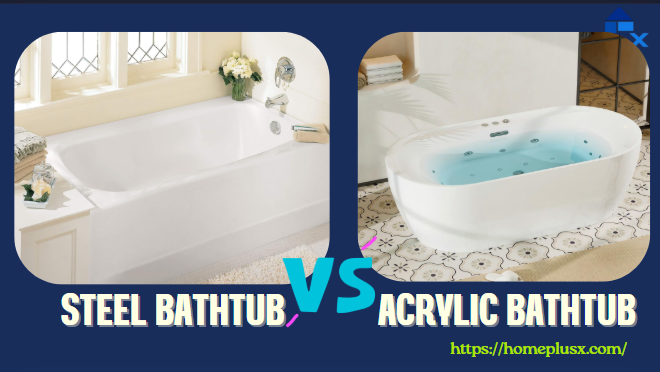
Are you planning to renovate your bath space to include a bathtub? Can’t decide whether to have a steel or acrylic bathtub.
Then, this post “steel vs acrylic bathtub “can help you a lot to decide between these two choices.
Steel and acrylic are two of the most popular bathtub materials nowadays. There are many benefits to both, which make these two materials close contenders.
So, it can be tricky to decide which one is best for you.
When it comes to choosing whether to have a steel bathtub or an acrylic one, you need to be well informed on why you might want to choose one or the other.
So, how do these two materials compare? Let us take a look.
This article will present the different pros and cons of Steel and Acrylic and how steel bathtubs differ from acrylic bathtubs.
Table of Contents
Steel Vs Acrylic Bathtub – How Do They Compare?
While comparing both types, I’ve considered the following criteria:
- Durability
- Style and Design Options
- Heat retention
- Ease of installation
- Ease of cleaning and maintaining
- Price/ Affordability
1. Durability
Steel:
Steel is much stronger than acrylic. This variation is also very rigid. For this reason, it is often an ideal family choice. The durable construction of steel tubs can easily withstand the test of time. This often reflects in the generous warranty period that comes with certain bathtub brands.
Steel tubs are more resistant to staining and scratches than acrylic tubs. Steel tubs that feature porcelain-enamel coating are prone to chipping if heavy items are dropped inside them. A little extra care can give a steel tub a longer lifespan.
Chips or other similar flaws may expose the metal core of the steel tub which increases the chance of rust.
Acrylic:
With advanced technology and manufacturing processes, acrylic tubs are just as robust as steel ones. However, because of the material’s flexibility, the chance of cracks is higher in acrylic-made tubs than steel ones.
Acrylic bathtub construction features fiberglass, which is covered in acrylic plastic. This construction gives this tub a unique plastic appearance that feels truly strong. This type of material is also resistant to rust.
Anything with a sharp edge or too much scrubbing can create scratches on acrylic tubs. Even harsh chemicals may negatively affect acrylic. However, it is easy to repair and polish out, unlike other materials. Different types of acrylic bathtub repair kits are available to get the job done.
2. Style and Design Options
Steel: Steel tubs are limited to design, shapes, and styles.
Acrylic: When it comes to diversity in design, acrylic tubs have a wider variety of shapes and styles. It is available in any shape- triangular, oval, square, and, of course, the classic claw-foot tub. So you have many options to match the décor of your bathroom.
3. Heat Retention
Steel:
Being a good conductor of heat, steel is not good at conserving heat. So, it makes the bath water cool down faster. Nevertheless, it takes less time for the tub to warm up when filled with warm water.
Acrylic:
Acrylic tubs are good at retaining heat. So, the water stays hotter longer. It makes filling the tub more economical. You can enjoy a relaxing, long, warm bath without refilling the tub with warm water to regulate the temperature of the water in the bath.
4. Ease of installation
Steel bathtubs are heavier than the acrylic alternative. The average weight of a steel tub is 150 to 200 pounds- some weigh even 500 pounds. This makes the installation process labor-intensive and tricky.
On the other hand, acrylic ones only weigh between 50 and 100 pounds. The lighter it is, the easier it will be to install. Acrylic baths are lightweight, so easy to transport and install.
Steel tubs don’t tend to flex and hold their shape. So, for installing this type of tub, you won’t need any special support system. On the other hand, acrylic tubs are less rigid than steel. So, they require support to prevent pressure points that may cause the tub to warp or crack.
5. Ease of cleaning and maintaining
Both types of tubs are easy to clean and maintain. However, acrylic tubs require regular cleaning to prevent mold and staining growth.
6. Price/ Affordability
Both the acrylic and steel baths are relatively inexpensive options compared to other bathtub materials such as stone, marble, and iron. But comparing these two choices in terms of price is somewhat difficult, as the price difference largely depends on the specific model.
Steel:
In general, a steel bathtub is a little pricier when compared to an acrylic one.
Acrylic:
These bathtubs tend to be more affordable than steel while providing almost the same design aesthetic and features. However, the more detailed the design of an acrylic tub, the higher the price tends to be.
A Quick Glimpse- Steel Vs Acrylic Bathtub
Don’t miss the following section.
| Feature | Steel Bathtub | Acrylic Bathtub |
|---|---|---|
| Durability | A wide range of styles and shapes is available | Flexible, scratch-prone, but easy to repair |
| Design Options | Limited styles and shapes | A wide range of styles and shapes are available |
| Heat Retention | Poor heat retention; cools water quickly | Excellent heat retention; keeps water warmer longer |
| Ease of Installation | Heavier and harder to install | Lightweight and easy to install |
| Maintenance | Low maintenance; resists stains | Requires gentle cleaning; can scratch easily |
| Affordability | Generally more expensive | Strong and rigid, prone to chipping and rust if damaged |
So, In the Steel Vs. Acrylic Bathtub Debate: Which Is the Winner?
There you have it…
From the above discussion, we’ve found that both materials have benefits and drawbacks, covering everything from strength, heat retention, ease of cleaning, price, and so on.
When compared in terms of versatility, smoothness, and ease of installation, acrylic baths are the winner. This type of tub is easy on the body, the eye, and the wallet. It’s lightweight, low-maintenance, comfortable, warm, and, best of all, it’s affordable.
On the other hand, steel baths are a better choice for you when it comes to durability, ease of cleaning, and maintenance. However, if you don’t like having a cold surface of steel, an acrylic bath is a better option for you.
At the end of the day, what is best for you all depends on what factors you prioritize.
Good luck on your bathtub buying journey!
FAQs: Steel Vs Acrylic Bathtub
Do acrylic bathtubs turn yellow?
Due to the non-porous nature of acrylic, it doesn’t absorb water. Moreover, it prevents mold and mildew build-up. This type of tub is manufactured by heating and molding a sheet of acrylic. The vacuum-formed material is then reinforced underneath with fiberglass. The color is solid throughout the construction, so there is no possibility of turning yellow for this type of tub.
What is the expected lifespan of an acrylic tub?
With proper care, this product may last around 10 to 15 years.
Is it okay to use vinegar on acrylic tubs to clean?
Yes, to gently clean the tub, you can use natural products like vinegar, lemon, and baking soda. You can also use commercial cleaning agents designed for acrylic tubs.
Is it safe to use bleach on an acrylic tub?
Many acrylic tub manufacturers warn against using bleach or other abrasive cleaners, as this “may void the warranty” on your bathtub. However, some users use liquid chlorine bleach diluted with water or slightly softer powdered oxygen bleach. They find it fine to use for ultra-deep. However, most manufacturers warn against using abrasive cleaners on acrylic tubs as it may void the warranty
Why do acrylic bathtubs crack?
Cracks tend to form in an acrylic tub for three possible reasons:
1. If your bathtub materials are flexible.
2. Damage from a heavy object.
3. Due to using heavy cleaners.
How heavy is a steel bathtub?
A porcelain-enameled 60-inch steel standard bathtub weighs about 75 pounds.
Is porcelain on a steel bathtub good?
Porcelain finish on steel makes the tub resistant to most chemicals and helps retaining its gloss for a long time.

Certified Pool & Spa Maintenance Specialist (CMS)
Patrick Martinez is a pool and hot tub professional. He is a Certified Pool & Spa Maintenance Specialist (CMS). He has a strong understanding of patio, spa, pool safety, maintenance, and water chemistry. (See Full Bio)